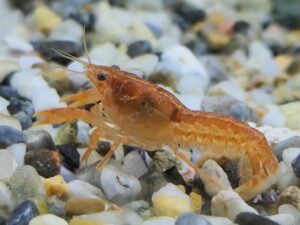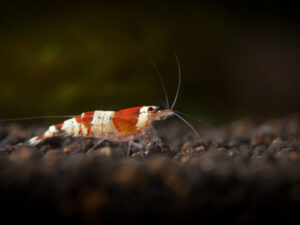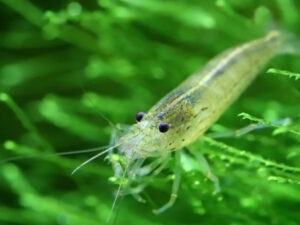Amano Shrimp are one of the most popular species in the aquarium trade. They are easily recognizable by their brown and white striped patterning. Amano Shrimp are native to freshwater streams and rivers in Eastern Asia.
They are peaceful, hardy, and easy to care for, making them an excellent choice for beginners and experienced aquarists. These shrimp are also very active and will often be seen grazing on algae and other detritus in the aquarium.
This guide will cover everything you need about Amano Shrimp care, including diet, habitat, tank mates, and more!
So, if you're interested in learning everything there is to know about Amano Shrimp, read on!
Table of Contents
- Amano Shrimp: Species Summary
- Amano Shrimp: Food & Diet
- Amano Shrimp: Care
- Amano Shrimp: Tank size
- Amano Shrimp: Water parameters
- Filtration
- Heating
- Lighting
- Live plants
- Co2 Systems
- Substrate
- Water Conditions
- Decorations
- Other Tank Accessories
- Water Change Schedules
- Cleaning The Tank
- Cleaning The Filter
- Testing The Water
- Amano Shrimp: Common Possible Diseases
- Tips For Keeping Amano Shrimp Healthy
- Amano Shrimp: Treatment And Medications Of Diseases
- Amano Shrimp: Tank Mates
- Amano Shrimp: Fish To Avoid
- Advantages Of Having Amano Shrimp In Your Tank
- Disadvantages Of Having Amano Shrimp In Your Tank
- Conclusion
Amano Shrimp: Species Summary
| Scientific name: | Caridina multidentata |
| Common names: | Amano Shrimp, Yamato Shrimp, Algae-eating shrimp, Japanese shrimp |
| Family: | Atyidae |
| Origin: | Freshwater streams and rivers in Eastern Asia |
| Size: | up to 2 inches |
| Life span: | 2-3 years |
| Behavior: | Peaceful, active |
| Tank size: | 10- Gallons |
| Water temperature: | 64°-82° Fahrenheit |
| Water hardness: | 5-15 dGH |
| pH range: | 6.5-7.5 |
| Water Type: | Freshwater |
| Activity level: | High |
| Swimming level: | Middle to bottom |
| Compatibility: | Community |
| Breeding: | Difficult |
| Care level: | Easy |
| Temperament: | Peaceful |
| Diet: | Peaceful fish, other shrimp |
Amano Shrimp: Appearance
Amano Shrimp are easily recognizable by their brown and white striped patterning. This distinctive coloration earned them the name "Yamato shrimp" in Japan.
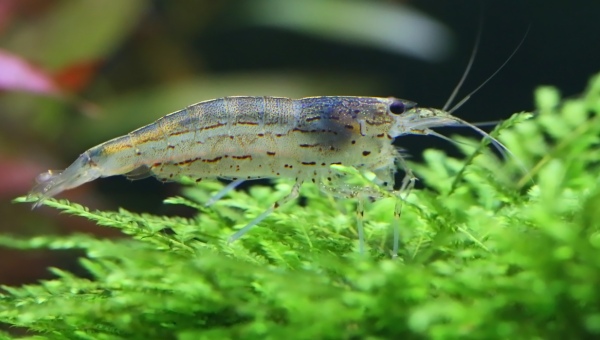
They are also notable for their large size and active nature. They are one of the largest shrimp species available in the aquarium trade and are constantly on the move!
Diet will play a role in determining the color of your Amano Shrimp. A diet rich in algae and other plant matter produces more colorful shrimp. Amano Shrimp are transparent, so you can sometimes see their internal organs!
These shrimp are very effective at camouflaging themselves among plant life and driftwood. It gives them an extra layer of protection against predators.
When shopping for your shrimp, look for individuals with transparent shells and no visible defects. Avoid shrimp that are pale or have cloudy eyes. These shrimp are likely sick and will not live long in captivity. A genuine Amano will have a brown and white striped pattern on its shell.
Amano Shrimp: Size & Growth Rate
The Amano Shrimp is one of the larger species available in the aquarium trade. They can grow up to 2 inches long, though they are typically closer to 1 inch in aquariums.
Their growth rate is relatively fast, especially compared to other shrimp species. They can grow from juvenile to adult in as little as two months!
However, their growth will slow down considerably once they reach adulthood.
Amano Shrimp: Lifespan
The average lifespan for a healthy Amano Shrimp in captivity is between two and three years. However, it is not uncommon for these shrimp to live for four years or more with proper care.
They can easily outlive most fish species, so they are often used as a "clean-up crew" in aquariums. They often graze on algae and other detritus in the tank.
Amano Shrimp: Breeding
Amano Shrimp are not known to breed in captivity. However, if they do breed, the female shrimp will carry the eggs under her abdomen until they hatch. Once the larvae hatch, they will be released into the water, where they will grow and develop into adults.
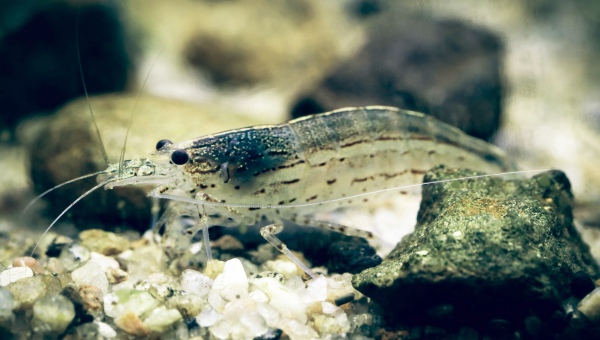
In the wild, female Amano Shrimp will lay their eggs in areas protected from predators. Once the larvae hatch, they will drift downstream, where they will grow and develop into adults.
Unfortunately, adults can easily die if not kept in the proper conditions. This makes it difficult for them to breed in captivity. If you are interested in breeding them, it is best to leave it to the experts.
It is tough to tell the difference between male and female Amano Shrimp. However, the female shrimp are generally larger than the males. And the female shrimp will have a broader abdomen when carrying eggs. So, if you see a shrimp with a broader abdomen, it is most likely a female.
Amano Shrimp: Behavior & Temperament
Amano Shrimp are generally peaceful animals that get along well with other tank mates. However, they can be aggressive toward each other if they are not getting enough food.
They are also known to be good cleaners and help keep your tank clean. They can also be seen eating algae as soon as it starts to grow in the tank. Their talent for eating algae makes them a popular choice for many aquarists.
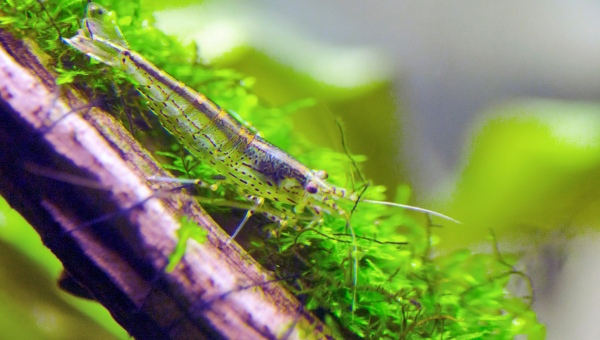
They love having plenty of hiding spots and are often seen perching on rocks or plants. They also enjoy swimming in open areas of the tank.
Like other shrimp, they are sensitive to changes in water parameters and should only be kept in a well-maintained aquarium. They will feel more secure if there are plenty of hiding spots available for them.
Amano Shrimp: Difference Between Male And Female
Whereas it can be pretty tricky to tell male and female Amano Shrimp apart, there are a few ways you can identify them. The first is by looking at the shape of their abdomens.
Males will have a more curved abdomen, while females will have straighter abdomen. Another way to tell the difference is by looking at the ventral (underside) of the shrimp.
Males will have a pair of tube-like structures called gonopodia, which transfer sperm to females during mating. Females will not have these structures. Finally, males tend to be larger and more brightly colored than females.
Amano Shrimp: Food & Diet
In nature, Amano Shrimp are omnivorous and will eat a variety of different foods. In the aquarium, they should be given a variety of foods to ensure that they are getting all the nutrients they need.
Some good food options for them include:
- Brine Shrimp: Brine shrimp is a good food option for Amano Shrimp. They are high in protein and provide a good source of nutrients.
- Daphnia: Daphnia are small, freshwater crustaceans that are a good source of protein for them.
- Algae wafers: Algae wafers also are a great food option for Amano Shrimp. They are high in nutrients and will help to keep the shrimp healthy.
- Bloodworms: Bloodworms are another great food option for them. They are high in protein.
- Mysis shrimp: Mysis shrimp are a good source of protein and essential nutrients.
- Krill: Krill are a good source of protein for them.
- Vegetables: Amano Shrimp will eat various vegetables, such as spinach, kale, and broccoli. But blanch the vegetables first and give them in moderation. Remove the veggies from your tank after a few hours if they are not eaten so they do not rot and pollute the water.
They should be given a variety of foods to ensure that they are getting all the nutrients they need.
Amano Shrimp: Diet Foods To Avoid
There are some foods that you should avoid feeding your Amano Shrimp.
These foods include:
- Bread: Bread is not a good food option for Amano Shrimp. It is high in carbohydrates and will cause problems for the shrimp.
- Cookies: Cookies are also not a good food option for them. They are high in sugar and will cause problems for the shrimp.
- Crustaceans: Crustaceans are not a good food option for them. They are high in cholesterol and will cause problems for the shrimp.
Amano Shrimp: Feeding Schedule
How often you should feed your Amano Shrimp will depend on a few factors, such as the size of the shrimp and the size of the tank. Generally, it would help if you fed your Amano Shrimp 2-3 times per week.
If you are feeding them live food, you should only feed them as much as they can eat in a few minutes. If you feed them frozen food, you should thaw it before feeding it.
Amano Shrimp: Care
Amano Shrimp is a popular choice for aquariums because they are relatively easy to care for. These shrimp are adaptable and can tolerate a wide range of water conditions.
They are also very effective at controlling algae growth in aquariums. They are peaceful and can be kept with a wide variety of tankmates.
Amano Shrimp: Tank size
Amano Shrimp can be kept in tanks as small as 10 gallons. However, it is best to keep them in larger tanks if possible. A 20-gallon tank is suitable for a small group of Amano Shrimp.
When setting up your tank, include plenty of hiding places for your shrimp. Amano Shrimp are constantly moving and need a lot of space to explore. Driftwood, live plants, and rocks can create a natural-looking environment for your shrimp.
Amano Shrimp: Water parameters
Amano Shrimp are very tolerant of different water conditions. They can be kept in both fresh and saltwater aquariums.
In a freshwater tank, the following parameters should be met:
- pH level: 7.2 to 7.5
- Temperature: 64° to 82° Fahrenheit
- Ammonia and nitrite levels: 0ppm
- Nitrate levels: less than 20ppm
In a saltwater tank, the following parameters should be met:
- pH level: 8.0 to 8.4
- Temperature: 70° to 82° Fahrenheit
- Ammonia and nitrite levels: 0ppm
- Nitrate levels: less than 20ppm
The water hardness in your tank is not as important as the other water parameters. Amano Shrimp can tolerate a wide range of water hardness levels.
They are susceptible to changes in water parameters. Sudden changes in pH, temperature, or ammonia levels can harm these shrimp. So be sure to acclimate your shrimp slowly and carefully before adding them to your tank.
The aquarium water should be well-filtered and well-oxygenated. Amano Shrimp are sensitive to poor water quality and will not survive in an unclean tank.
Filtration
When choosing a filter for your Amano Shrimp tank, be sure to choose one suitable for your tank's size. A good rule of thumb is to choose a filter that can turn over the entire volume of your tank at least four times per hour.
Amano Shrimp are very sensitive to high levels of nitrate and ammonia in the water. Be sure to perform regular water changes to remove these toxins from your tank. A general guideline is to perform a 25% water change every two weeks.
Some recommended filters for Amano Shrimp tanks include:
- Fluval Canister Filter: These filters effectively filter toxins and keep the water clean. They are also reticent and easy to maintain.
- Aqua Clear Power Filter: These filters also effectively filter toxins and keep the water clean. They are available in a wide range of sizes to suit different-sized tanks.
- Sponge Filter: These filters are a good choice for smaller tanks. They are very effective at filtering out toxins and keeping the water clean.
Heating
Amano Shrimp can tolerate a wide range of temperatures. The water should be kept at 64° to 82° Fahrenheit in a freshwater tank. The water should be kept at 70° to 82° Fahrenheit in a saltwater tank.
You must use an aquarium heater if your home is not naturally warm enough to maintain these temperatures. Be sure to choose a heater suitable for your tank's size.
Some recommended heaters for Amano Shrimp tanks include:
- Eheim Jager Aquarium: This Heater is very reliable and easy to use. It is also fully submersible, making it safe for use in aquariums.
- Fluval Edge: This Heater is also very reliable and easy to use. It is designed for small aquariums, making it a good choice for shrimp tanks.
- Hydor Theo Aquarium: Heater is fully submersible and has adjustable temperature control. It is a good choice for larger aquariums.
Lighting
Amano Shrimp do not require special lighting. A standard aquarium hood with fluorescent bulbs will provide enough light for your shrimp tank.
If you are keeping live plants in your tank, you may need a higher-wattage bulb to provide enough light for the plants to grow.
Some recommended bulbs for Amano Shrimp tanks include:
- Zoo Med Aqua Sun Aquarium Hood: This hood has two high-quality fluorescent bulbs. It is a good choice for larger aquariums.
- Fluval Sea Marine & Reef Full Spectrum Fluorescent Light: These are designed for saltwater aquariums. It provides full-spectrum lighting, which is beneficial for live plants.
- Marineland Double Bright LED Light: It is very bright and energy-efficient. It is a good choice for larger aquariums.
Live plants
Amano Shrimp are constantly on the move and love to explore their environment. Driftwood, live plants, and rocks can create a natural-looking environment for your shrimp.
Amano Shrimp are also known to eat algae. So including some live plants in your tank can help control the algae growth.
Some recommended plants for Amano Shrimp tanks include:
- Anubias: These plants are very tough and can withstand much abuse. They are also straightforward to care for and do not require much fertilizer.
- Bucephalandra: These plants are very slow-growing and can live for many years. They are also straightforward to care for and do not require much fertilizer.
- Cryptocoryne: These plants are trendy in aquariums. They come in various colors and can tolerate various environmental conditions.
Co2 Systems
Amano Shrimp do not require a CO2 system. However, if you are keeping live plants in your tank, you may need to use a CO2 system to provide the plants with the carbon dioxide they need to grow.
Some recommended CO2 systems for Amano Shrimp tanks include:
- Fluval Pressurized CO2 Kit: This CO2 kit is straightforward and designed for small aquariums.
- AquaVista 500 Automatic Aquarium CO2 System: This CO2 system is straightforward and designed for larger aquariums.
- Tetra Easy Strips 6-in-1 Aquarium Test Strips: These test strips are very easy to use and will help you monitor the carbon dioxide levels in your tank.
Substrate
The substrate in your Amano Shrimp tank should be soft and sandy. This will prevent the shrimp from being injured when they fall.
Amano Shrimp are also known to eat algae. So including some live plants in your tank can help control the algae growth.
Some recommended substrates for Amano Shrimp tanks include:
- Fluval Plant and Shrimp Stratum: This substrate is made from natural clay and is ideal for planted tanks. It is also rich in minerals and nutrients, which benefit shrimp.
- Aquarium Co-Op Eco-Complete: This substrate is made from recycled materials and is very eco-friendly. It is also rich in minerals and nutrients, which benefit shrimp.
- Aqua soil: This substrate is made from natural clay and is ideal for planted tanks. It is also rich in minerals and nutrients, which benefit shrimp.
Water Conditions
Amano Shrimp are very tolerant of a wide range of water conditions. However, they prefer water that is slightly acidic with a pH of 6.5 to 7.5. The temperature of the water should be between 64° to 82° Fahrenheit.
Amano Shrimp are also very sensitive to high levels of ammonia and nitrates. So it is important to ensure the water in your tank is well-filtered and has a stable temperature.
Decorations
Amano Shrimp are very active and love to explore their environment. Driftwood, live plants, and rocks can all be used to create a natural-looking environment for your shrimp.
Amano Shrimp are also known to eat algae. So including some live plants in your tank can help to keep the algae growth under control.
Some recommended decorations for Amano Shrimp tanks include:
- Driftwood: Driftwood can be used to create a natural-looking environment for your shrimp.
- Live plants: Live plants are a great way to add color and interest to your tank.
- Rocks: Rocks can be used to create a natural-looking environment for your shrimp. They can also help to keep the algae growth under control.
Other Tank Accessories
Other accessories that can be added to your Amano Shrimp tank include:
- Aquarium Thermometer: An aquarium thermometer is necessary to monitor the water temperature.
- pH Meter: A pH meter is necessary to monitor the water's pH.
- Air Pump: An air pump is necessary to provide aeration for the water.
Water Change Schedules
Water changes are an important part of shrimp care. So it is important to ensure the water in your tank is well-filtered and has a stable temperature.
A weekly water change of 10-15% is recommended for Amano Shrimp tanks.
When changing the water, you should:
- Remove all decorations from the tank.
- Vacuum the substrate to remove any waste.
- Fill the tank with fresh, dechlorinated water.
- Add the decorations back into the tank.
- Monitor the water parameters closely for the next few days.
Cleaning The Tank
It is important to make sure that the tank is cleaned regularly. The tank should be vacuumed, and the substrate should be replaced every 2-3 weeks.
When cleaning the tank, you should:
- Clearing out any uneaten food or decaying matter.
- Vacuum the substrate to remove any waste.
- Replace the substrate with a fresh, clean substrate.
After you have finished cleaning the tank, you should check the water parameters to make sure that the water is still safe for your shrimp.
Cleaning The Filter
Cleaning the filter is an important part of shrimp care. A dirty filter can cause the water to become polluted and can lead to the death of your shrimp.
The filter should be cleaned every 2-3 weeks. When cleaning the filter, you should:
- Remove the filter media from the filter.
- Rinse the filter media in dechlorinated water.
- Place the filter media back in the filter.
- Monitor the water parameters closely for the next few days.
Testing The Water
Testing the water is an important part of shrimp care. Water tests can help you to monitor the water parameters and make sure that the water is safe for your shrimp.
They are susceptible to high levels of ammonia and nitrates. So it is important to test the water regularly. If any of these levels are not within the safe range, you should take steps to correct the problem immediately.
By following these tips, you can help to ensure that your Amano Shrimp stay healthy and happy.
Amano Shrimp: Common Possible Diseases
Amano Shrimp are very sensitive to water quality and can be susceptible to diseases if the water conditions are not ideal.
Some common diseases that they may face include:
- Bacterial Infections: Bacterial infections are one of the most common problems with Amano Shrimp. These infections can be caused by poor water quality or a dirty tank.
- Viral Infections: Viral infections are another common problem with them. These infections can be caused by poor water quality or stress.
- Fungal Infections: Fungal infections are another common problem with them. These infections can be caused by poor water quality or stress.
Symptoms of these infections include:
- Loss of appetite
- Lethargy
- Cloudy eyes
- White spots on the body
If you suspect that your shrimp has any of these infections, you should take steps to improve the water quality and clean the tank immediately. You may also need to treat the shrimp with medication.
Tips For Keeping Amano Shrimp Healthy
There are some things that you can do to help keep your Amano Shrimp healthy.
These tips include:
- Provide a clean and well-maintained tank.
- Monitor the water parameters closely.
- Perform regular water changes.
- Keep the tank free of debris and uneaten food.
- Avoid using harsh chemicals or medications in the tank.
- Quarantine new shrimp before adding them to the main tank.
By following these tips, you can help to ensure that your Amano Shrimp stay healthy and happy.
Amano Shrimp: Treatment And Medications Of Diseases
If your Amano Shrimp becomes sick, there are some things that you can do to treat the disease.
The first step is to identify the disease. Once you have done this, you can then choose a medication that will treat the disease.
Some common medications used to treat diseases in them include:
- Criflavine: This medication is used to treat bacterial and fungal infections.
- Copper Sulfate: This medication is used to treat viral and bacterial infections.
- Furan-2: This medication is used to treat bacterial infections.
- Methylene Blue: This medication is used to treat fungal infections.
- Neomycin: This medication is used to treat bacterial infections.
- Nitrofurazone: This medication is used to treat bacterial infections.
- Tetracycline: This medication is used to treat bacterial infections.
- Malachite Green: This medication is used to treat fungal and bacterial infections.
Some of these medications are available over the counter, while others will need to be prescribed by a veterinarian. If you are unsure which medication to use, you should consult a veterinarian before using any medications.
Once you have chosen a medication, you should follow the instructions carefully. Overdosing the shrimp can be dangerous and may even kill them.
Amano Shrimp: Tank Mates
These shrimp can do just fine with other shrimp and fish that won't try to eat them. They will enjoy the company of other peaceful tank mates.
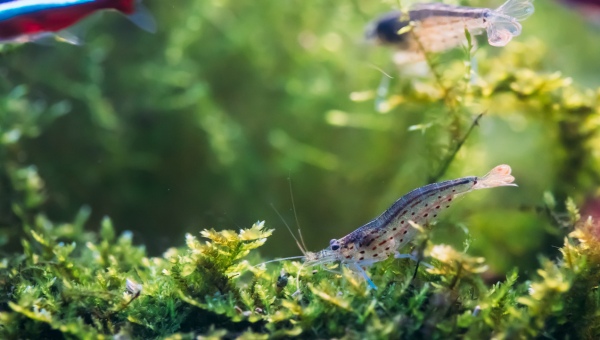
Some good tank mates for them include:
Numerous freshwater snails make great companions for Amano Shrimp as well. The shrimp will often pick at the snail's shells, which helps to keep them clean.
Some of the best snail companions for them include:
- Golden Inca snails
- Malaysian trumpet snails
- Assassin snails
- Ramshorn snails
- Mystery snails
- Ivory snails
- Japanese trapdoor snails
Amano Shrimp: Fish To Avoid
There are a few fish that you should avoid keeping with them.
These fish include:
- Bettas: Bettas are aggressive fish that will often attack and eat shrimp.
- Gouramis: Gouramis are also aggressive fish that often attack and eat shrimp.
- Barbs: Barbs are aggressive fish that can damage the shrimp's delicate exoskeleton.
- Cichlids: Cichlids are aggressive fish that can damage the shrimp's delicate exoskeleton.
Advantages Of Having Amano Shrimp In Your Tank
The first advantage of having Amano Shrimp in your tank is that they are great algae eaters. If you have a problem with algae, these shrimp will help to keep it under control.
Another advantage is that they are good scavengers. They will help to clean up any uneaten food or debris that is in the tank. This helps to keep the water quality high and the tank clean.
Amano Shrimp are also known to be good tank mates. They will get along with other shrimp and fish that are peaceful. This makes them a good choice for community tanks.
Disadvantages Of Having Amano Shrimp In Your Tank
One disadvantage of having Amano Shrimp in your tank is that they are sensitive to changes in water parameters. This means that you need to be extra careful about maintaining the water quality in your tank.
Another disadvantage is that they are not easy to breed in captivity. If you are interested in breeding them, it is best to leave it to the experts.
Conclusion
As you can see, there are both advantages and disadvantages to having Amano Shrimp in your tank. However, overall, these shrimp make a great addition to most tanks. They are good algae eaters, good scavengers, and good tank mates. So, if you are looking for shrimp that can help to keep your tank clean and tidy, the Amano Shrimp is a good choice.
I hope this article has helped you to understand more about Amano Shrimp. If you have any questions, please feel free to leave them in the comments below.
Thanks for reading!

